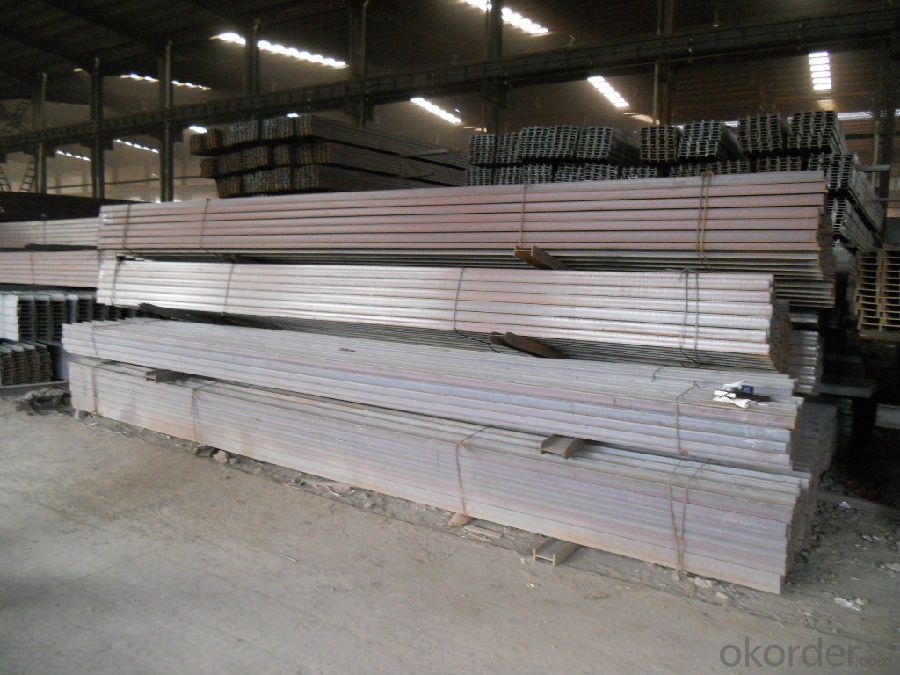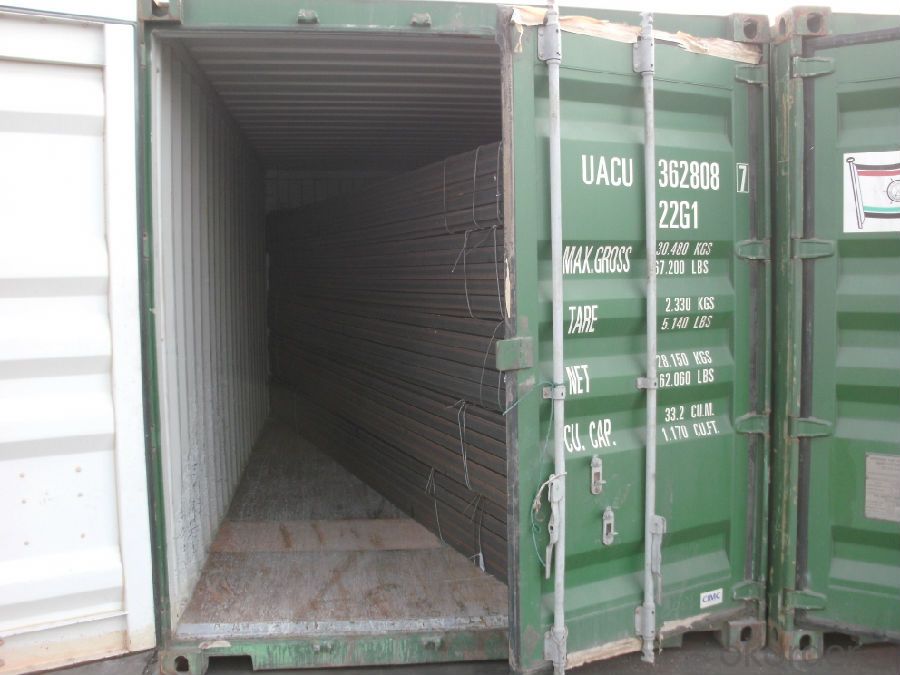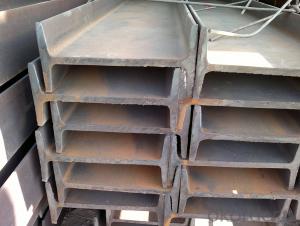Hot Rolled Steel I Beams for support structrue
- Loading Port:
- Tianjin
- Payment Terms:
- TT OR LC
- Min Order Qty:
- 10000 m.t
- Supply Capability:
- 250000 m.t/month
OKorder Service Pledge
OKorder Financial Service
You Might Also Like
Item specifice
Product Description:
OKorder is offering Hot Rolled Steel I Beams for support structrue at great prices with worldwide shipping. Our supplier is a world-class manufacturer of steel, with our products utilized the world over. OKorder annually supplies products to European and Asian markets. We provide quotations within 24 hours of receiving an inquiry and guarantee competitive prices.
Product Applications:
Hot Rolled Steel I Beams for support structrue are widely used in various construction structures, bridges, autos, brackets, mechanisms and so on.
Product Advantages:
OKorder's Hot Rolled Steel I Beams for support structrue are durable, strong, and resist corrosion.
Main Product Features:
· Premium quality
· Prompt delivery & seaworthy packing (30 days after receiving deposit)
· Corrosion resistance
· Can be recycled and reused
· Mill test certification
· Professional Service
· Competitive pricing
Product Specifications:
1. Product name: Hot Rolled Steel I Beams for support structrue
2. Standard: EN10025, GB Standard, etc.
3. Grade: Q235B, A36, Q345, SS400 or other equivalent.
4. Length: 5.8M, 6M, 9M, 10M, 12M or as your requirements

Section | Standard Sectional Dimensions(mm) | ||||
h | b | s | t | Mass Kg/m | |
IPE80 | 80 | 46 | 3.80 | 5.20 | 6.00 |
IPE100 | 100 | 55 | 4.10 | 5.70 | 8.10 |
IPE120 | 120 | 64 | 4.80 | 6.30 | 10.40 |
IPE140 | 140 | 73 | 4.70 | 6.90 | 12.90 |
IPE160 | 160 | 82 | 5.00 | 7.40 | 15.80 |
IPE180 | 180 | 91 | 5.30 | 8.00 | 18.80 |
IPE200 | 200 | 100 | 5.60 | 8.50 | 22.40 |
IPE220 | 220 | 110 | 5.90 | 9.20 | 26.20 |
IPE240 | 240 | 120 | 6.20 | 9.80 | 30.70 |
IPE270 | 270 | 135 | 6.60 | 10.20 | 36.10 |
IPEAA80 | 80 | 46 | 3.20 | 4.20 | 4.95 |
IPEAA100 | 100 | 55 | 3.60 | 4.50 | 6.72 |
IPEAA120 | 120 | 64 | 3.80 | 4.80 | 8.36 |
IPEAA140 | 140 | 73 | 3.80 | 5.20 | 10.05 |
IPEAA160 | 160 | 82 | 4.00 | 5.60 | 12.31 |
IPEAA180 | 180 | 91 | 4.30 | 6.50 | 15.40 |
IPEAA200 | 200 | 100 | 4.50 | 6.70 | 17.95 |
5.Color marking: There will be color marking on both end of the bundle for the cargo delivered by bulk vessel. That makes it easily to distinguish at the destination port.
Tag mark: there will be tag mark tied up on the bundles. The information usually including supplier logo and name, product name, made in China, shipping marks and other information request by the customer.
If loading by container the marking is not needed, but we will prepare it as customer request.
6. Shipment: In containers or in bulk cargo
FAQ:
Q1: Why buy Hot Rolled Steel I Beams for Construction from China from OKorder.com?
A1: All products are carefully selected from China's most reliable manufacturing enterprises. Through its ISO certifications, OKorder.com adheres to the highest standards and a commitment to supply chain safety and customer satisfaction. We can guarantee the quality!
Q2: The products are invoicing on theoretical weight or on actual weight?
A2: We can do it in both manners, it’s according to buyer's requirement.
Images:


- Q:How are steel I-beams used in commercial construction?
- Steel I-beams are commonly used in commercial construction due to their strength, versatility, and cost-effectiveness. These beams are typically made of high-quality steel and are shaped like the letter "I," with a horizontal top flange, a vertical web in the middle, and another horizontal bottom flange. In commercial construction, steel I-beams are primarily used as structural components to support the weight of the building and transfer loads to the foundation. They are commonly used for constructing floors, roofs, and walls, as well as in the framework of bridges and other large structures. One of the main advantages of steel I-beams is their ability to span long distances while supporting heavy loads. The shape of the I-beam provides excellent strength-to-weight ratio, allowing it to carry significant loads without excessive weight. This makes it possible to create large open spaces within commercial buildings, such as warehouses, shopping centers, and industrial facilities, without the need for additional columns or supports. Steel I-beams also offer flexibility in design and construction. They can be customized to meet specific structural requirements, such as the desired span, load capacity, and overall design aesthetics. This adaptability allows architects and engineers to create efficient and functional commercial spaces while ensuring structural integrity. Additionally, steel I-beams are highly durable and resistant to fire, corrosion, and pests, making them suitable for long-term use in commercial buildings. They require minimal maintenance compared to other construction materials, reducing overall lifecycle costs. In summary, steel I-beams are essential components in commercial construction due to their strength, versatility, and cost-effectiveness. They provide structural support, enable the creation of large open spaces, and offer design flexibility. Their durability and low maintenance requirements make them an ideal choice for long-lasting and efficient commercial buildings.
- Q:Do you use brackets made of I-beam and angle steel to make the following?
- A small roadside shop with non-standard thin iron sheet metal, can be used only on the line, angle, hole does not require gun drill on the line, the material utilization rate is high, can be used, must use the iron bearing.
- Q:Can steel I-beams be used in renovation projects?
- Certainly, renovation projects often involve the utilization of steel I-beams. These robust and enduring beams are commonly employed in both construction and renovation endeavors. Their exceptional strength and durability make them highly sought-after. Typically, they serve as load-bearing supports, reinforcing preexisting structures or facilitating the creation of fresh openings in walls or floors. By installing steel I-beams, one can bear substantial weight and secure structural stability, rendering them perfect for a range of renovation applications. For instance, they are frequently implemented in the addition of extra floors, the expansion of room sizes, or the support of a new roof. Moreover, steel I-beams are versatile, effortlessly conforming to specific project requirements. As a result, they are a favored choice in renovation projects that prioritize structural integrity.
- Q:What are the different types of steel coatings used on I-beams?
- There are several different types of steel coatings used on I-beams, including galvanized coatings, epoxy coatings, and polyurethane coatings. These coatings provide various levels of protection against corrosion, abrasion, and environmental factors, ensuring the longevity and durability of the I-beams in different applications.
- Q:How do steel I-beams contribute to energy efficiency in buildings?
- Steel I-beams contribute to energy efficiency in buildings in several ways. Firstly, steel is a highly durable material that can withstand heavy loads, allowing for the construction of larger and taller buildings. This enables the use of efficient building designs, such as open floor plans and large windows, which maximize natural light and ventilation, reducing the need for artificial lighting and HVAC systems. Additionally, steel I-beams have a high strength-to-weight ratio, meaning they can support heavier loads with less material compared to other building materials. This allows for the construction of lighter and more efficient structures, reducing the overall energy consumption during construction and minimizing the environmental impact. Moreover, steel I-beams can be fabricated off-site with precision, reducing construction time and minimizing waste. This streamlined construction process further contributes to energy efficiency by reducing the energy required for on-site activities and minimizing construction-related carbon emissions. Lastly, steel is a recyclable material, and steel I-beams can be easily salvaged and reused in other construction projects. This promotes sustainability by reducing the demand for new steel production, which is an energy-intensive process. Overall, the use of steel I-beams in building construction enhances energy efficiency through their durability, lightweight nature, efficient fabrication process, and recyclability.
- Q:What are the common accessories used with steel I-beams, such as brackets and connectors?
- Common accessories used with steel I-beams include brackets, connectors, cleats, hangers, bolts, and plates. These accessories are essential for providing structural support, connecting beams together, securing them to other components, and ensuring the overall stability and integrity of the I-beam structure.
- Q:Can steel I-beams be used in educational or institutional building construction?
- Yes, steel I-beams can certainly be used in educational or institutional building construction. In fact, steel I-beams are widely used in the construction industry for their strength, durability, and versatility. They provide excellent structural support and can withstand heavy loads, making them suitable for large-scale buildings such as schools, universities, and other educational or institutional facilities. Steel I-beams offer several advantages in educational or institutional building construction. Firstly, they have a high strength-to-weight ratio, which means they can support heavy loads while minimizing the overall weight of the structure. This allows for more efficient and cost-effective construction, as it reduces the need for excessive materials and foundation support. Additionally, steel I-beams can be easily fabricated and customized to meet specific design requirements. They come in various sizes and shapes, allowing for flexible design possibilities. This versatility is particularly beneficial in educational or institutional buildings, as it allows for the creation of large open spaces, such as auditoriums or gymnasiums, without the need for excessive supporting columns. Moreover, steel I-beams are resistant to fire, rot, and pests, ensuring the longevity and safety of the building. They also have a long lifespan, requiring minimal maintenance over time. This makes them a reliable choice for educational or institutional buildings that are expected to have a long operational life. In conclusion, steel I-beams are highly suitable for educational or institutional building construction due to their strength, durability, versatility, and cost-effectiveness. They provide the necessary structural support, allow for flexible design possibilities, and ensure the safety and longevity of the building.
- Q:What are the different grades of steel used in manufacturing I-beams?
- I-beams in manufacturing commonly use several grades of steel. These grades comprise A36, A572, A992, and A588. A36 steel, due to its strength and versatility, is the most frequently utilized grade for I-beams. It possesses a minimum yield strength of 36,000 psi and a minimum tensile strength ranging from 58,000 to 80,000 psi. A36 steel finds extensive application in construction and structural uses. A572 steel, another favored grade for I-beams, particularly in the construction sector, possesses a minimum yield strength of 50,000 psi and a minimum tensile strength ranging from 65,000 to 85,000 psi. A572 steel is renowned for its high strength and excellent weldability. A992 steel, a relatively new grade, has gained increasing popularity in recent years. It possesses a minimum yield strength of 50,000 psi and a minimum tensile strength ranging from 65,000 to 85,000 psi. A992 steel offers improved strength and durability compared to A36 and A572, making it suitable for a diverse range of applications. A588 steel, a grade with high strength and low alloy content, frequently finds use in structural applications like bridges and buildings. It possesses a minimum yield strength of 50,000 psi and a minimum tensile strength ranging from 70,000 to 95,000 psi. A588 steel is renowned for its corrosion resistance and ability to withstand harsh environmental conditions. In conclusion, the selection of the steel grade for I-beam manufacturing relies on project-specific requirements, encompassing strength, durability, and corrosion resistance.
- Q:How do you calculate the load capacity of a steel I-beam?
- To calculate the load capacity of a steel I-beam, you need to consider its dimensions, material properties, and the specific loading conditions. The load capacity can be determined by analyzing the beam's moment of inertia, its section modulus, and the allowable stress for the specific steel grade. Engineering formulas and calculations are used to determine these parameters, ensuring that the beam can safely support the anticipated loads without exceeding its maximum allowable stress.
- Q:What are the factors to consider when designing steel I-beams for heavy machinery support?
- When designing steel I-beams for heavy machinery support, there are several factors that need to be considered to ensure the structural integrity and safety of the support system. These factors include: 1. Load requirements: The first and foremost factor is to determine the maximum load that the I-beams need to support. This includes both the static and dynamic loads that the heavy machinery will exert on the beams. Engineers must calculate the weight and distribution of the loads to determine the appropriate size and strength of the I-beams. 2. Material selection: Choosing the right type of steel for the I-beams is crucial. The material should have high strength and resistance to deformation under heavy loads. Commonly used steel grades for heavy machinery support include ASTM A36, ASTM A572, and ASTM A992. 3. Beam size and shape: The dimensions of the I-beams should be carefully considered to ensure they can adequately support the loads. This includes determining the height, width, and thickness of the flanges and web of the beams. The shape of the I-beams should be optimized to provide the best strength-to-weight ratio. 4. Beam spacing and support structure: The spacing between the I-beams needs to be determined to evenly distribute the load and prevent excessive deflection. The support structure, such as columns or walls, should be designed to provide adequate stability and stiffness to hold the I-beams securely in place. 5. Welding or bolted connections: The method of connecting the I-beams needs to be chosen carefully. Welded connections are commonly used for heavy machinery support due to their strength and durability. However, bolted connections can provide flexibility for future modifications or repairs. 6. Safety and code compliance: The design should adhere to relevant safety standards and building codes. This includes considering factors such as seismic design requirements, fire resistance, and load capacity factors. 7. Cost considerations: Lastly, the cost of materials, fabrication, and installation should be taken into account. Engineers need to find a balance between meeting the load requirements and minimizing costs without compromising safety. By carefully considering these factors, engineers can design steel I-beams that provide robust and reliable support for heavy machinery, ensuring safety and optimal performance in industrial settings.
1. Manufacturer Overview |
|
|---|---|
| Location | |
| Year Established | |
| Annual Output Value | |
| Main Markets | |
| Company Certifications | |
2. Manufacturer Certificates |
|
|---|---|
| a) Certification Name | |
| Range | |
| Reference | |
| Validity Period | |
3. Manufacturer Capability |
|
|---|---|
| a)Trade Capacity | |
| Nearest Port | |
| Export Percentage | |
| No.of Employees in Trade Department | |
| Language Spoken: | |
| b)Factory Information | |
| Factory Size: | |
| No. of Production Lines | |
| Contract Manufacturing | |
| Product Price Range | |
Send your message to us
Hot Rolled Steel I Beams for support structrue
- Loading Port:
- Tianjin
- Payment Terms:
- TT OR LC
- Min Order Qty:
- 10000 m.t
- Supply Capability:
- 250000 m.t/month
OKorder Service Pledge
OKorder Financial Service
Similar products
New products
Hot products
Related keywords




























